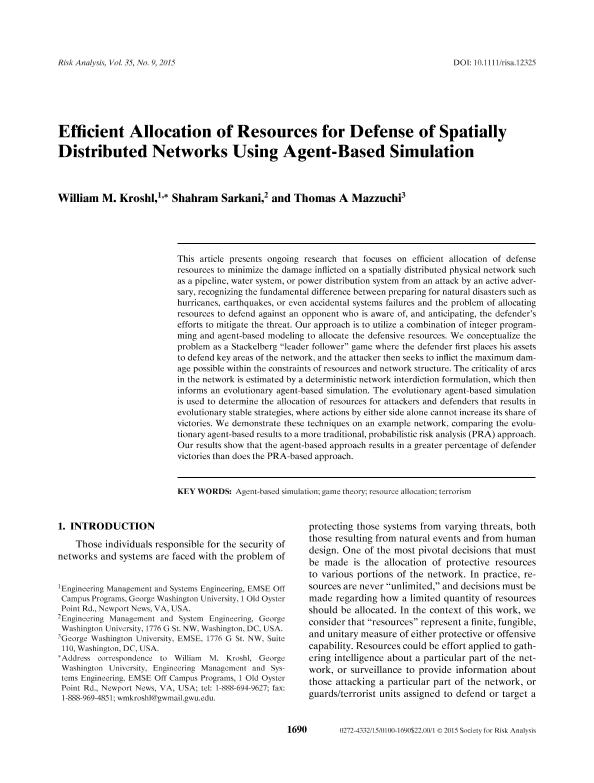Efficient allocation of resources for defense of spatially distributed networks using agent-based simulation

Contenido multimedia no disponible por derechos de autor o por acceso restringido. Contacte con la institución para más información.
| Tag | 1 | 2 | Value |
|---|---|---|---|
| LDR | 00000cab a2200000 4500 | ||
| 001 | MAP20150038463 | ||
| 003 | MAP | ||
| 005 | 20151120144930.0 | ||
| 008 | 151117e20150901esp|||p |0|||b|spa d | ||
| 040 | $aMAP$bspa$dMAP | ||
| 084 | $a7 | ||
| 100 | 1 | $0MAPA20150019196$aKroshl, William M. | |
| 245 | 1 | 0 | $aEfficient allocation of resources for defense of spatially distributed networks using agent-based simulation$cWilliam M. Kroshl, Shahram Sarkani, Thomas A. Mazzuchi |
| 520 | $aThis article presents ongoing research that focuses on efficient allocation of defense resources to minimize the damage inflicted on a spatially distributed physical network such as a pipeline, water system, or power distribution system from an attack by an active adversary, recognizing the fundamental difference between preparing for natural disasters such as hurricanes, earthquakes, or even accidental systems failures and the problem of allocating resources to defend against an opponent who is aware of, and anticipating, the defender's efforts to mitigate the threat. Our approach is to utilize a combination of integer programming and agent-based modeling to allocate the defensive resources. We conceptualize the problem as a Stackelberg "leader follower" game where the defender first places his assets to defend key areas of the network, and the attacker then seeks to inflict the maximum damage possible within the constraints of resources and network structure. The criticality of arcs in the network is estimated by a deterministic network interdiction formulation, which then informs an evolutionary agent-based simulation. The evolutionary agent-based simulation is used to determine the allocation of resources for attackers and defenders that results in evolutionary stable strategies, where actions by either side alone cannot increase its share of victories. We demonstrate these techniques on an example network, comparing the evolutionary agent-based results to a more traditional, probabilistic risk analysis (PRA) approach. Our results show that the agent-based approach results in a greater percentage of defender victories than does the PRA-based approach. | ||
| 650 | 4 | $0MAPA20080556808$aTerrorismo | |
| 650 | 4 | $0MAPA20080591250$aGestión de recursos | |
| 650 | 4 | $0MAPA20080587345$aRedes informáticas | |
| 650 | 4 | $0MAPA20080588953$aAnálisis de riesgos | |
| 650 | 4 | $0MAPA20080586454$aModelos analíticos | |
| 650 | 4 | $0MAPA20080560607$aSimuladores | |
| 650 | 4 | $0MAPA20080603038$aPrevención de riesgos | |
| 700 | 1 | $0MAPA20150019202$aSarkani, Shahram | |
| 700 | 1 | $0MAPA20150019219$aMazzuchi, Thomas A | |
| 773 | 0 | $wMAP20077000345$tRisk analysis : an international journal$dMcLean, Virginia : Society for Risk Analysis, 1987-2015$x0272-4332$g01/09/2015 Volumen 35 Número 9 - septiembre 2015 , p. 1690-1705 |

